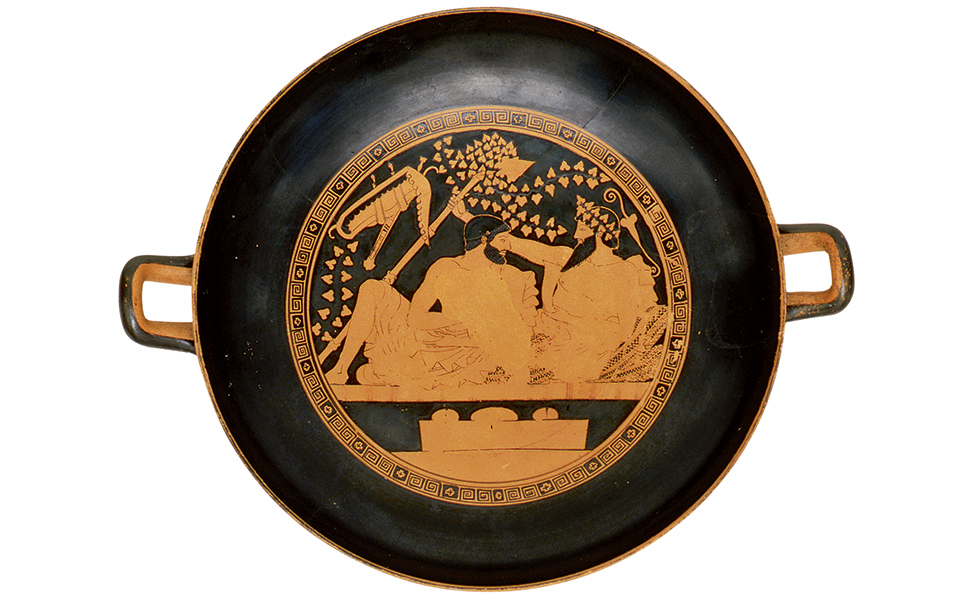Some of our most essential pleasures or comforts in life can be traced so far back in human history that they seem to disappear into the mists of time. The cultivation and consumption of grapes and their juice (preferably fermented) is a prime example. Nevertheless, as archaeologists, in collaboration with palaeobotanists, have further extended and refined their reach, we now know that wine was likely first enjoyed and systematically produced during the Neolithic period, some 6,000 to 7,000 years ago. It was during this early era, when people in the Near East, and in the Greek world, first began to leave the nomadic life and settle down (“put down roots”!), that we see the appearance of human-cultivated or reared (ultimately “domesticated”) plants and animals. Neolithic homesteaders were the first to experience a life more like our own, with the satisfaction of a permanent roof over one’s head, a fire in the hearth, a reassuring stock of foodstuffs, a companionable dog to provide security and a soothing cup of wine on a winter’s evening.
“The fact that winemaking was already so well developed in 4000 BC suggests that the technology probably goes back much earlier.”
Eastern Origins
Grape vines, like other plants now characteristic of Greece and the Mediterranean region, seem originally to have migrated westward from the Middle East. At Hajji Firuz Tepe, in the northern Zagros Mountains of Iran, the 1968 discovery of storage jars, embedded in the kitchen floor of a mudbrick dwelling dated to ca. 5400-5000 BC, revealed the presence of yellowish and reddish salts from tartaric acid – a substance that naturally occurs most significantly in grapes. Other evidence points to Georgia and Armenia, at the eastern end of the Black Sea, as areas of earliest grape cultivation. A full-fledged winery, containing a wine press, fermentation vats, jars, cups and traces of grape seeds and vines (Vitis vinifera), was unearthed in 2007 in the Areni-1 cave complex in Vayots Dzor, Armenia. Terebinth resin also detected there may have been added to the wine as a preservative. Specialist Patrick McGovern comments: “The fact that winemaking was already so well developed in 4000 BC suggests that the technology probably goes back much earlier.”
In the Mediterranean, wine residues bearing traces of tartaric acid have also been identified on fragments of distinctive, nipple-based storage jars in the Erimi area of southwestern Cyprus. Maria Rosaria Belgiorno, reporting in 2005, describes the Cypriot residues (ca 5500 BC) as “…the earliest examples of Mediterranean winemaking…,” predating by some 1,500 years previous evidence of wine production discovered in Crete and northern Greece. A 1989 excavation in House 1 at Neolithic Dikili Tash, in eastern Macedonia, 1.5km east of ancient Philippi, revealed the pips and skins of a carbonized pile of crushed grapes, dated to ca 4300 BC – the earliest evidence of Aegean winemaking. Two-handled cups on the site are also linked with the drinking of wine.
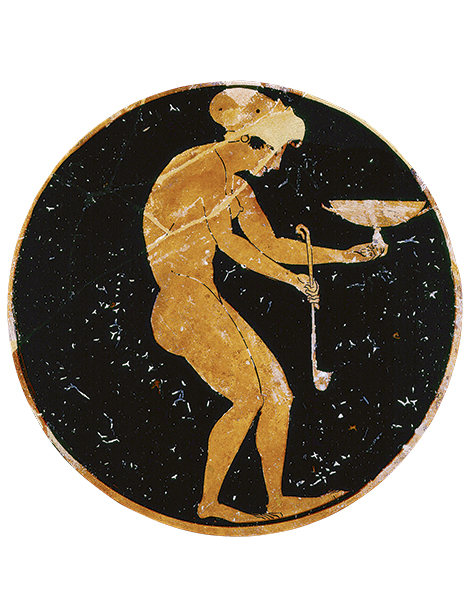
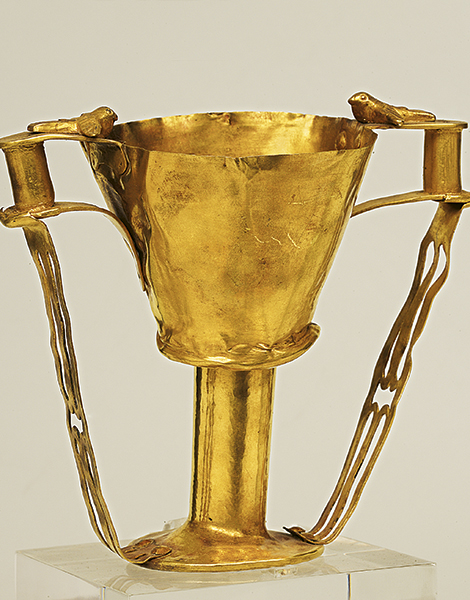
King Nestor’s Banquets
The practice of ceremonial and convivial imbibing of wine developed in the Bronze Age Greek world through the fourth, third and second millennia BC, until we find such well-stocked party venues as the Mycenaean-era palace of King Nestor of Pylos, in the southwestern Peloponnese (destroyed ca 1200 BC). There, storerooms contained large wine jars and, in one pantry, smashed on the floor, a total of 2,853 long-stemmed, two-handled wine cups – kylikes – the forerunners of present-day chalices or goblets. In Crete, the Minoans, who likely influenced the oenological culture of the mainland Mycenaeans, drank wine from horn-shaped rhytons, while the name Oinops (“wine-colored”) appears on Linear B tablets at Knossos.
Clearly, conventions concerning the production and sharing of wine had become highly refined by the Mycenaean Late Bronze Age, during which harvest festivals (“the Feast of the Wine”) were established; dark, sweet varieties of the beverage appeared, such as the dessert wine still known in Cyprus and today called Commandaria; and Dionysus – or a similar deity resembling him – likely first emerged as the divine patron of drinking, dancing and ecstatic behavior (see box). The Mycenaeans became consummate traders of wine, inserting themselves into an increasingly international Mediterranean “market” and shipping their goods both eastward, to Cyprus, Egypt and the Levant, and westward, to Sicily and southern Italy. Already, wine played a key role in economic, religious, social and even medical aspects of everyday Greek life. Wine represented the first real global, and globalizing, commercial product, which brought together regions, towns, ports and people. Followed closely by olive oil, wine acquired a level of economic demand that fostered long-distance contacts and led to the creation of progressively complex infrastructures and grape/wine-related beliefs and traditions.
“Wine represented the first real global, and globalizing, commercial product, which brought together regions, towns, ports and people.”
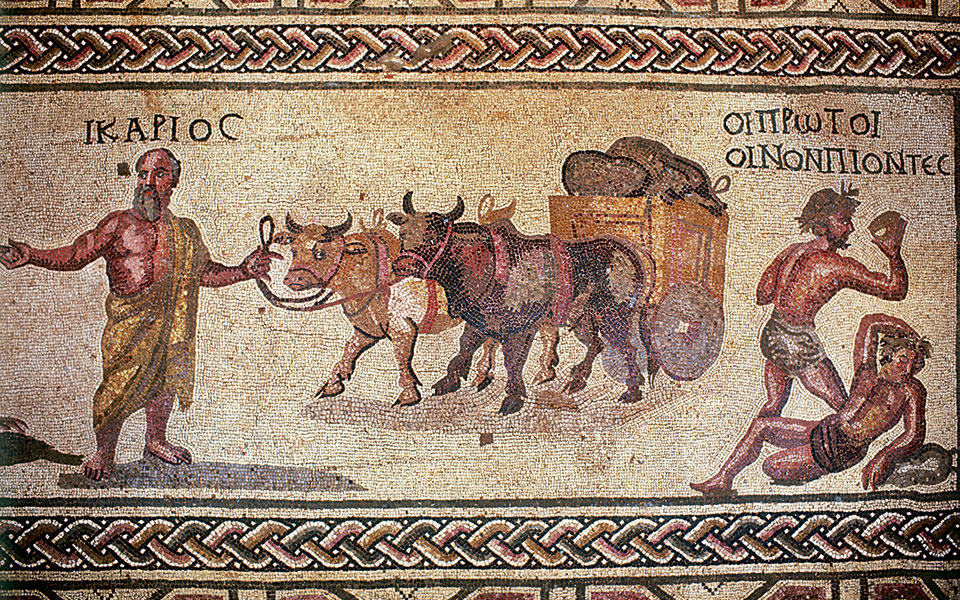
© Sonia Halliday Photographs / Bridgeman Images - De Agostini Picture Library / G. Dagli Orti / Bridgeman Images
Homer and Wine
By the 8th and 7th centuries BC, when the written works of Hesiod and the Homeric bards (“Homer”) began to appear, wine had thoroughly permeated Greek culture and become a ubiquitous, sometimes central feature – a dietary staple, preferable to water, drunk at any time of day or night, with or without food. Greeks had learned to cut their wine with water; Hesiod advocated a dilution of three parts water to one part wine (25% strength), while Alcaeus of Mytilene (late 7th-6th c BC) called for a stronger mixture of 2:1 (33% strength). To drink in moderation was the norm, comments Zinon Papakonstantinou: “Such drinking was viewed as both liberating and socially responsible and became a widely accepted ideal of upper-class alcoholic consumption in Archaic and Classical Greece.”
A favorite epithet in Homer’s Iliad and Odyssey is “wine-dark,” used, for example, in reference to the sea or the color of oxen. “Pramnian” wine, too, is often mentioned – as a general term for good dark (red) wines, especially those of Lesbos, Icaria and Smyrna. The existence of many types of wine is implied by Homer’s description of Laertes, Odysseus’ father, whose vineyard is said to include over 50 different grape varieties. A knowledge of sun-dried grapes for sweeter, more intense “raisin” or “straw” wine is also attested, not only by Homer but also Hesiod, who cites the sun-dried “Cypriot Manna” grape, perhaps the precursor of the Commandaria type. At Troy, Agamemnon’s stock of wine, brought over by traders from Lemnos, came from Thrace.
The qualities of wine, both good and bad, are illustrated in Homeric epic when Hecabe, Hector’s mother, advises him to offer libations and reinvigorate himself with wine. Odysseus likewise suggests that Greek warriors fortify themselves and bolster their courage by taking their fill of food and wine before battle, while, in ordinary civilian life, agricultural field workers are depicted on Achilles’ shield as receiving a cup of honey-sweet wine at the end of every plowed row.
“The qualities of wine, both good and bad, are illustrated in Homeric epic when Hecabe, Hector’s mother, advises him to offer libations and reinvigorate himself with wine.”
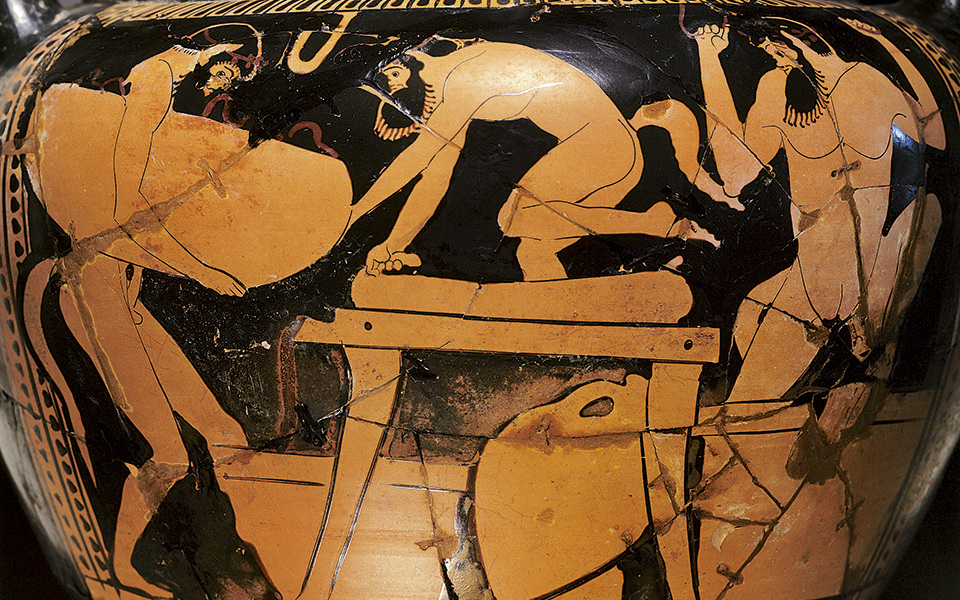
Nevertheless, wine’s powerful effects are also acknowledged when Hector subsequently demurs. Odysseus cautions that wine can lead even the wisest man to frivolous behavior, such as excessive laughter, dancing, and speaking out of turn. When, in disguise, he requests a turn at stringing the great bow at the last dinner with Penelope’s suitors, they perceive him as drunk and remind him of the rude party antics exhibited by the Centaurs at the Lapith wedding – an iconic mythological example of wine-induced, uncivilized, socially unacceptable behavior that later shows up in the decorative southern metopes of the Parthenon.
The power of unmixed wine is demonstrated by Odysseus, when he tricks the Cyclops Polyphemus with such reckless imbibing, after which the wily traveler and his men finally escape from the giant’s cave. At other times, wine was employed as an ingredient in mixed potations, such as the archetypal barley-based beverage (kykeon) drunk by Nestor and Machaon at Troy. Homer’s scenes of elite feasting and drinking illuminate the close connection between these activities and military and political power – with the best meat, exquisite wine and seats of special honor at banquets being selectively offered as privileges of elevated social status. Characteristic of such gatherings were finely crafted and decorated banqueting equipment, exemplified by Homer through Nestor’s golden, two-handled drinking cup.
Wine and drinking paraphernalia were considered appropriate high-status gifts for foreign guests and other visitors. Odysseus receives a silver mixing bowl and a dozen containers of unmixed sweet wine from a priest of Apollo, while his son Telemachus is presented with a drinking cup and a krater by Sparta’s king Menelaus.
“Odysseus cautions that wine can lead even the wisest man to frivolous behavior, such as excessive laughter, dancing, and speaking out of turn.”

